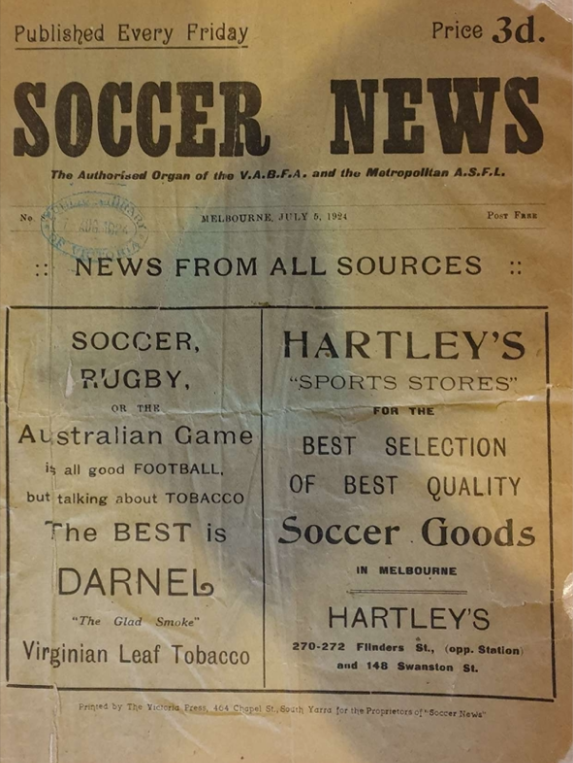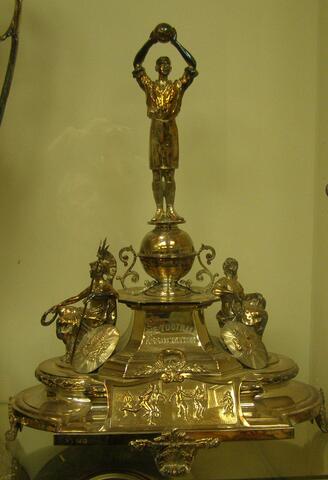Football between the wars
The First World War had interrupted a sharp rise in immigration into Australia. In the aftermath of war thousands of migrants from Britain and some from other parts of Europe arrived in Australia. Between 1921 and 1925, 36,700 immigrants landed, the largest increase in a five-year period since gold rush days. Victoria benefited from this influx, and several new industries were created. For example, in Geelong the Ford Motor Company began operations in 1926, the Valley Mills Worsted Mill was formed as a private company in 1924, and the highly profitable Commonwealth Woollen Mills were sold off to a local consortium in somewhat suspicious circumstances in 1923. Each of these three firms had teams associated with them playing football in Geelong by the mid-1920s.
Football matches in Victoria resumed in 1919 with a new record attendance being established in a second-round Dockerty Cup match between Northumberland & Durham United (league champions in both 1919 and 1920) and Melbourne Thistle at Middle Park on 3 July 1920. The first division of the league now had 12 teams, with matches being played at Middle Park and reserve games at Spotswood. A number of new clubs were formed, including Coburg (1916), Box Hill (1922), Yallourn (1923), Brighton (1924), Heidelberg (1925), Hakoah (1927) and South Yarra (1928). Most of these were Anglo clubs, though Hakoah was to maintain a strong Jewish presence off the field until well after the Second World War. Victorian football players remained overwhelmingly Anglo, though one or two continental players began to appear, including Schaufelberger of St Kilda, a member of the Swiss Consular Staff in Melbourne, while Melbourne Welsh signed Larenzo, a new arrival from Italy.
Australian-born junior players were now beginning to come through, opening up the possibility of a domestic dimension to this immigrant game. A club for those who considered themselves Australian, Austral, was formed and played for several seasons in the lower leagues. The game was expanding in non-metropolitan centres. Country leagues and cup competitions were being held in Wangaratta and Benalla District, Wonthaggi, Yallourn, Bendigo and Colac by 1926. Mildura brought a representative team to Melbourne in 1927. The Dockerty Cup was now attracting teams from Wonthaggi, Bendigo and Geelong.
A demonstration charity match was played in Geelong on Monday, 26 April 1920, between a team from the crews of the visiting warship HMAS Platypus and its accompanying submarines and the Victorian Amateur British Football Association team, Windsor. The Geelong United Soccer Club was formed in 1923 and entered division two of the metropolitan competition in 1924.

Whatever its later image, football was an extremely convivial game between the wars. Hardly a match which involved travelling for one of the teams passed without a post-match meal or a dance or both, interrupted by numerous toasts and self-congratulatory speeches by the participants, which were reported at length in the local press. The predominantly British migrants probably had less of a cultural gap to bridge than many who came later, but there is no doubt that football helped them on their way—providing contacts, support networks, boosting business and helping support local industries, including the domestic manufacture of football boots and balls.
Victorian football in the 1920s and 1930s also had a strong international dimension. Victoria welcomed teams from Hong Kong, England, Palestine, India and Czechoslovakia to play ‘tests’ against Victorian and Australian selections. Well-attended matches were played at the Fitzroy Cricket Ground (present day Brunswick St Oval), the Melbourne Cricket Ground and other venues. The media even began to take notice. For the first time, in 1928, the Sporting Globe assigned a permanent member of staff to report on the game. The use of cricket and footy ovals and the growth in numbers attending provoked some fear in rival codes. Much of the press comment was about the threat of soccer to local football.
Just when it seemed that football might take off as a major sport, it shot itself in the foot by a major split in both New South Wales and Victoria. In the North, the top clubs broke away to form a state league to concentrate the top players and revenue in the hands of an elite. In Victoria, a proposal to organise the competition on a district or suburban basis led to some clubs breaking away to form their own organisation. To participants in the game, these moves made sense, but to outsiders they meant little but confusion. The only way of distinguishing the rival factions in Victoria was an adjective and a conjunction, as the Melbourne Metropolitan District Association struggled with the Melbourne and District Association for the loyalty of supporters, players and referees, who also split, with half going to one body and half to the other.
In 1924 the Football Association (FA) in England presented a Challenge Cup to the Australian Football Association for competition on interstate lines. This was one of number of trophies given to the various overseas associations which were affiliated to the FA at the time. The one given to Australia is currently displayed in the Football Victoria boardroom. There was an interstate carnival in Sydney in 1932. Victoria, South Australia, Tasmania and Queensland and NSW took part, with the host coming out on top. The last pre-war carnival was held in Adelaide in 1936, again won by New South Wales.

The Victorian schism had just been mended in March 1929 when economic depression was to compound the problems the game was making for itself. Attendances remained small, though they tested the limits of the facilities available, and clubs struggled to establish bases in their local communities. In Geelong in 1930 the league was in decline, with only four teams taking part, and it folded in 1931. The Geelong Association did revive by 1934, however, and entered a Geelong United team in the metropolitan competition.
By 1936 there were eight teams in the Victorian division one and nine in division two, with at least a couple in a third division and also two reserve divisions, a junior competition and a schools competition for the Dunkling Cup. The ‘international’ and interstate matches continued, and international touring teams arrived at irregular intervals. Even juniors were travelling interstate to play matches. A South Australian schools team played four matches in Victoria for one win, one loss and two draws, while a Victorian junior team played in Adelaide. In that year too, the Australian senior team went to New Zealand to play a series of three test matches. Australia won the last match by four goals to one. The crowd was put at about 1,000. In the previous test Australia had won by ten goals to nil before 8,000 in Wellington. In contrast to small crowds in New Zealand, there was a claimed attendance of 45,000 (of whom 36,690 paid) to see England defeat New South Wales by three goals to one in July 1937.
Football continued to be played during the Second World War, with an attenuated league of eight clubs. Some clubs amalgamated temporarily during the war to continue playing. Moreland and Hakoah won the first division in 1943 and the Dockerty Cup in 1945. Works teams, particularly those in war related industries, prospered. Nobels was league champion in 1938 and completed a hat-trick of successes as Imperial Chemical Industries (ICI) in the following two years. Junior leagues at Under-20, Under-17 and Under-15 were also played.
